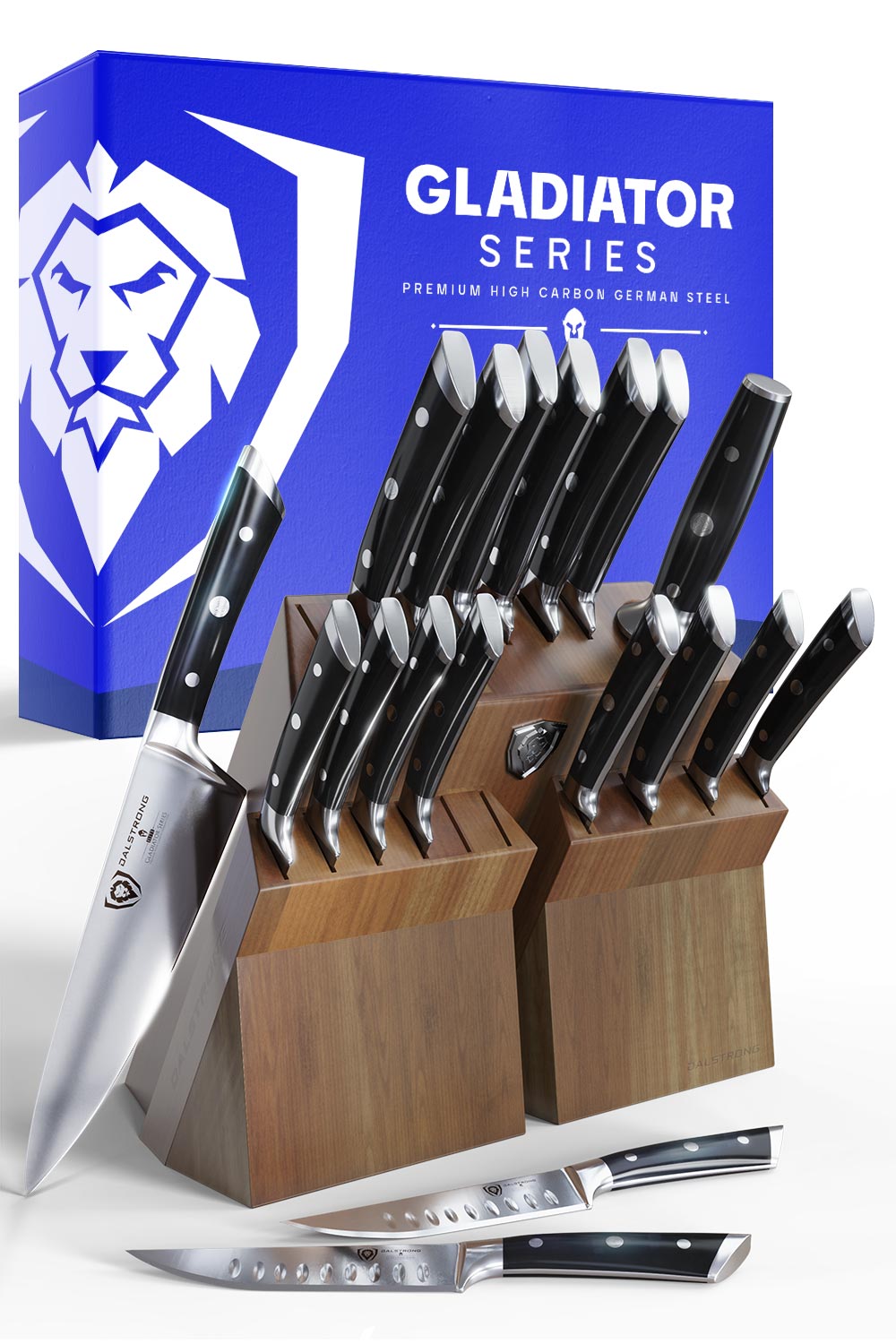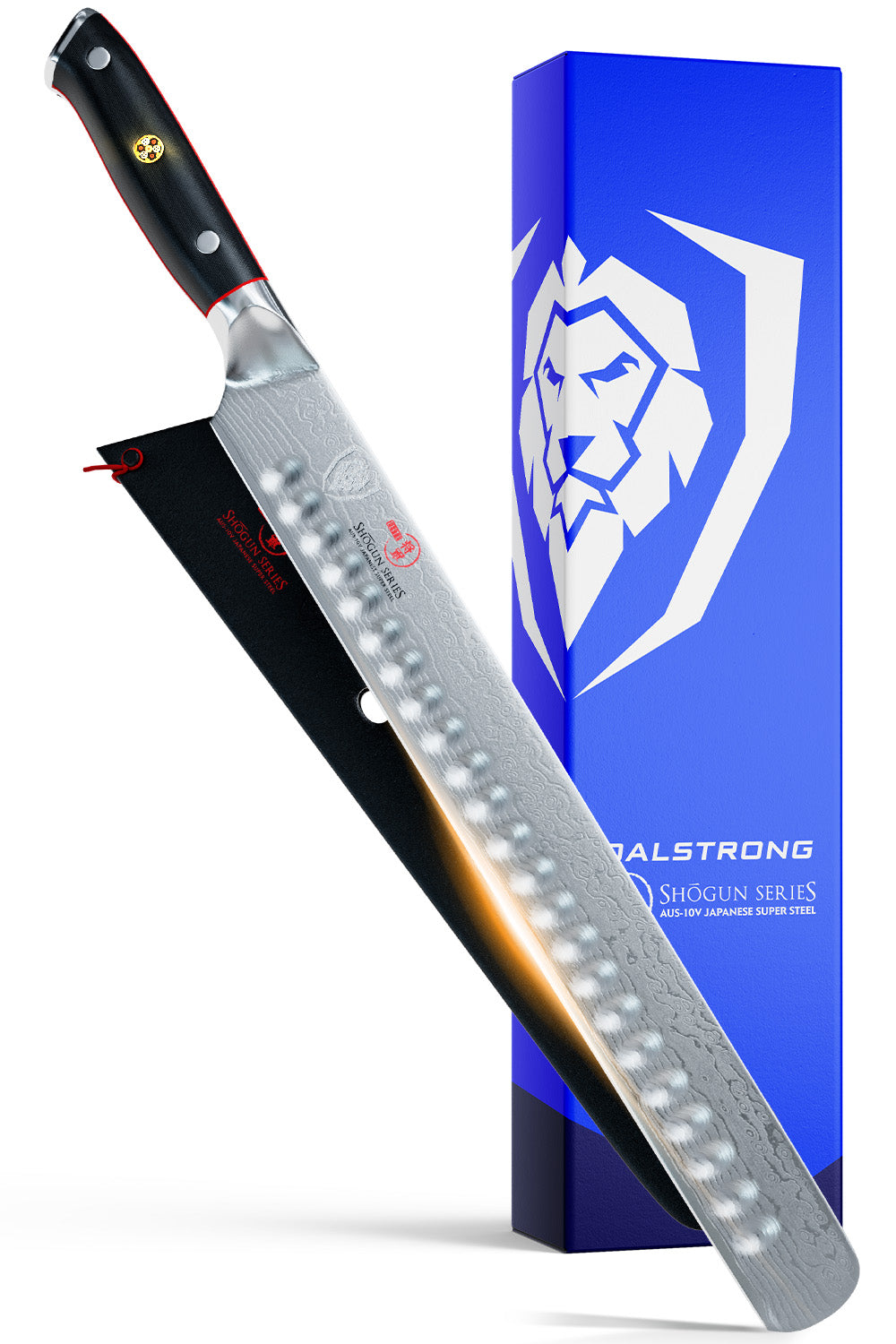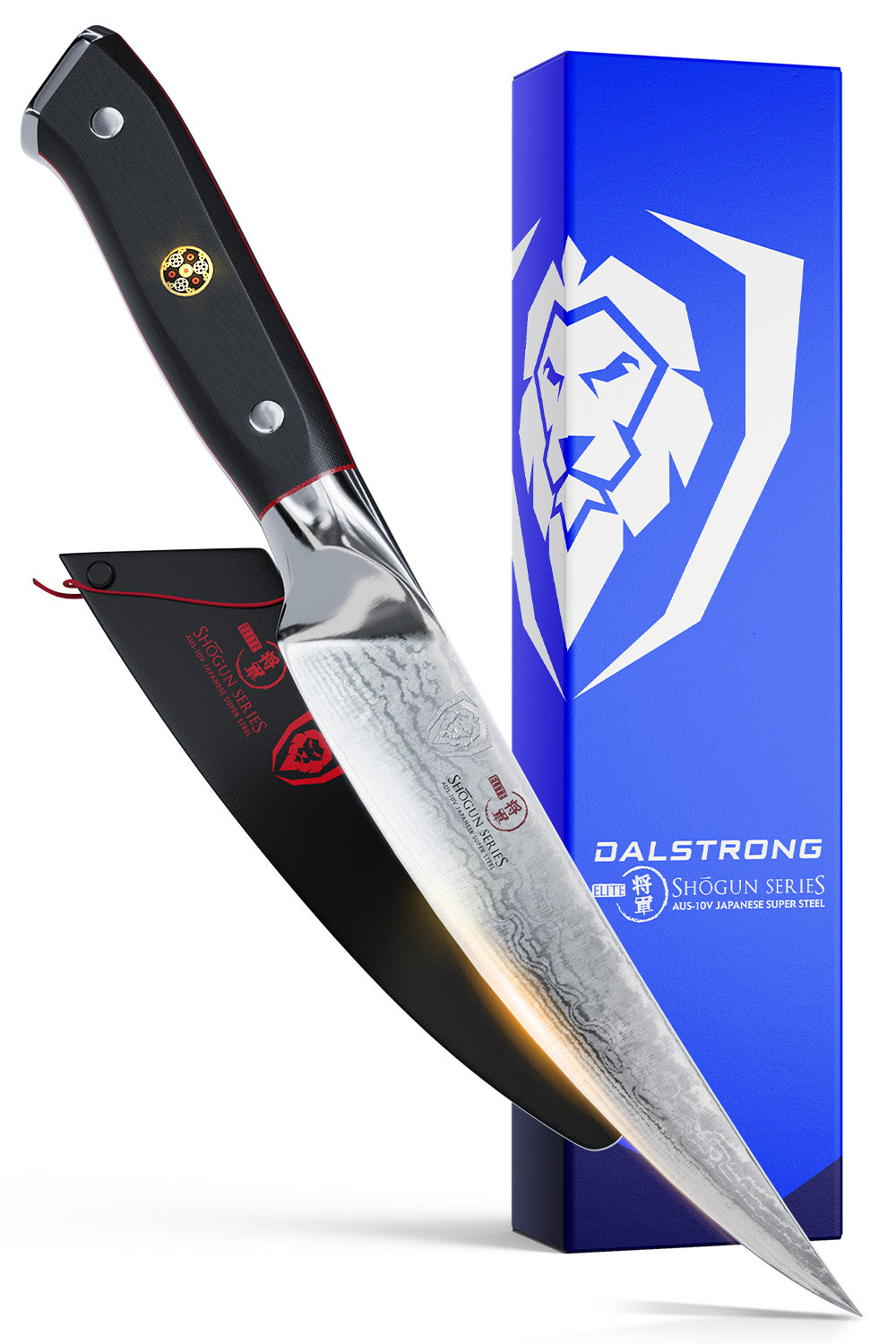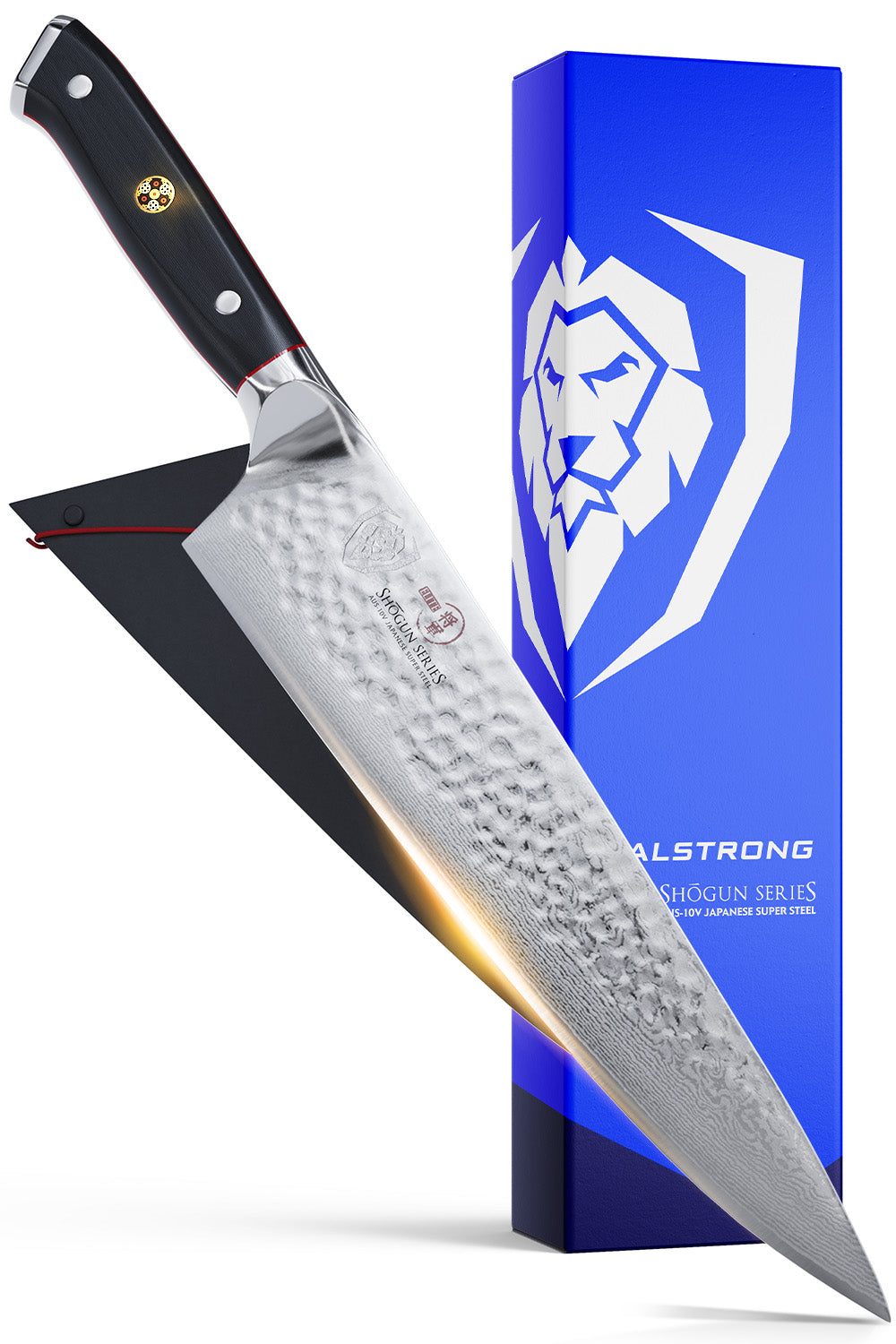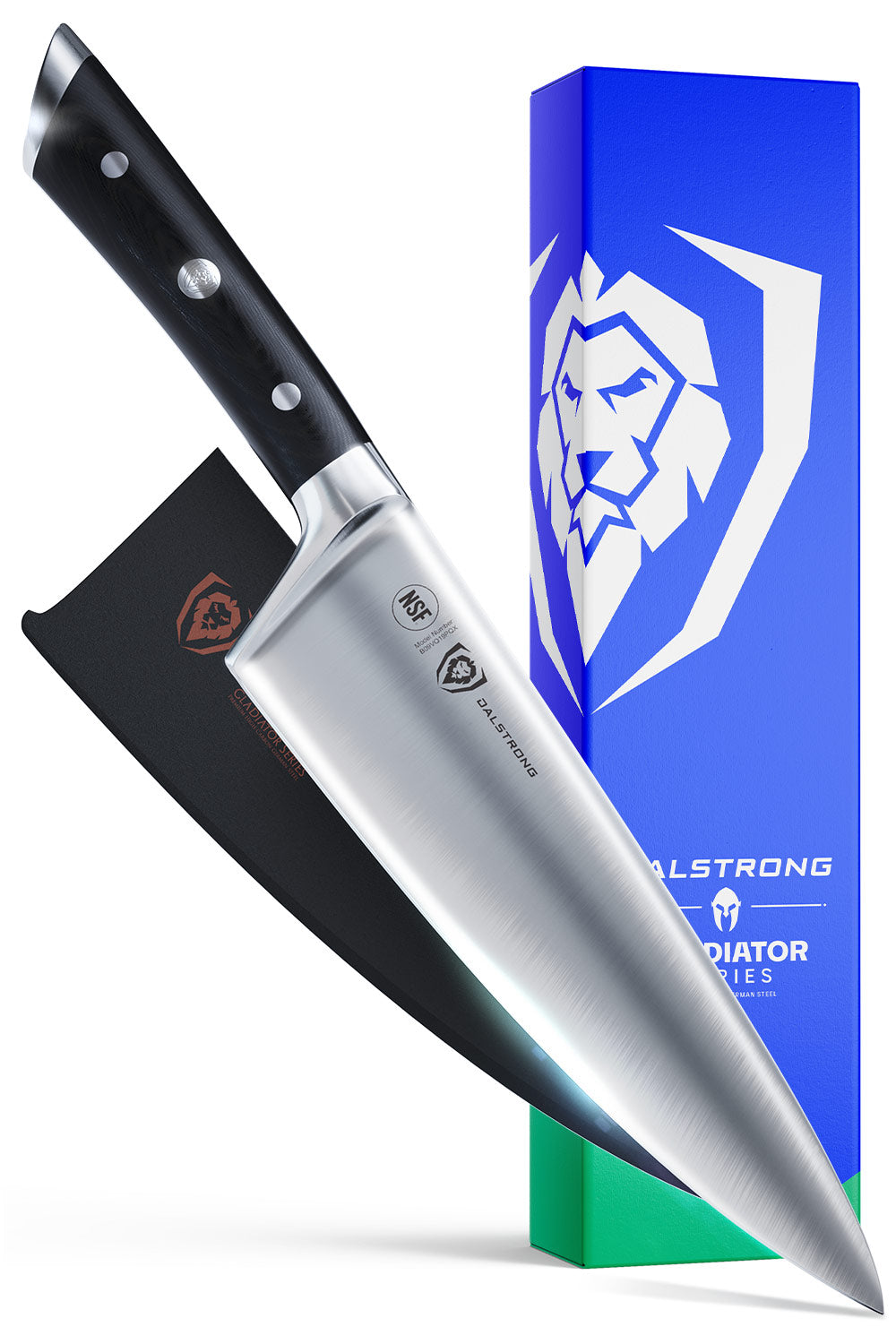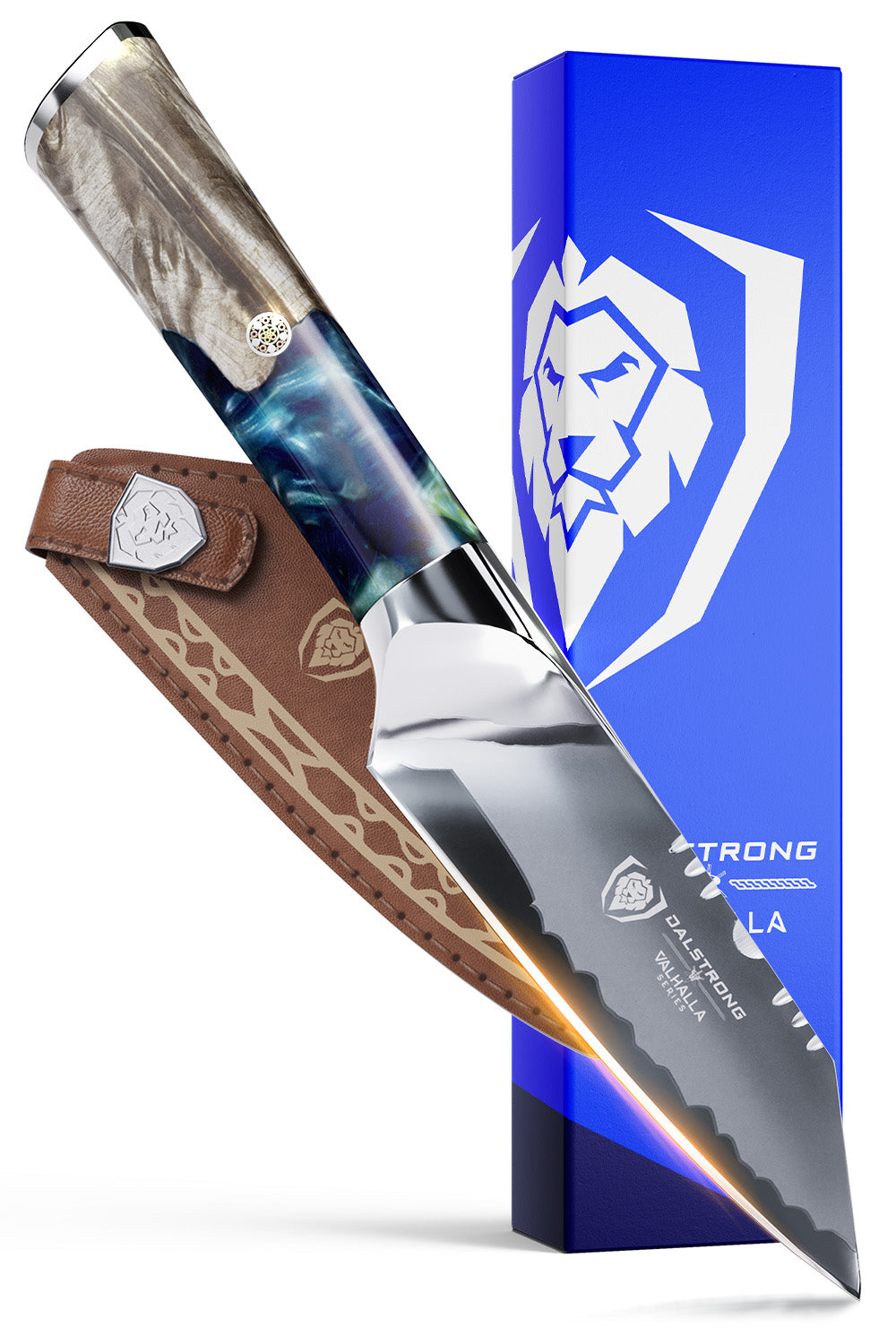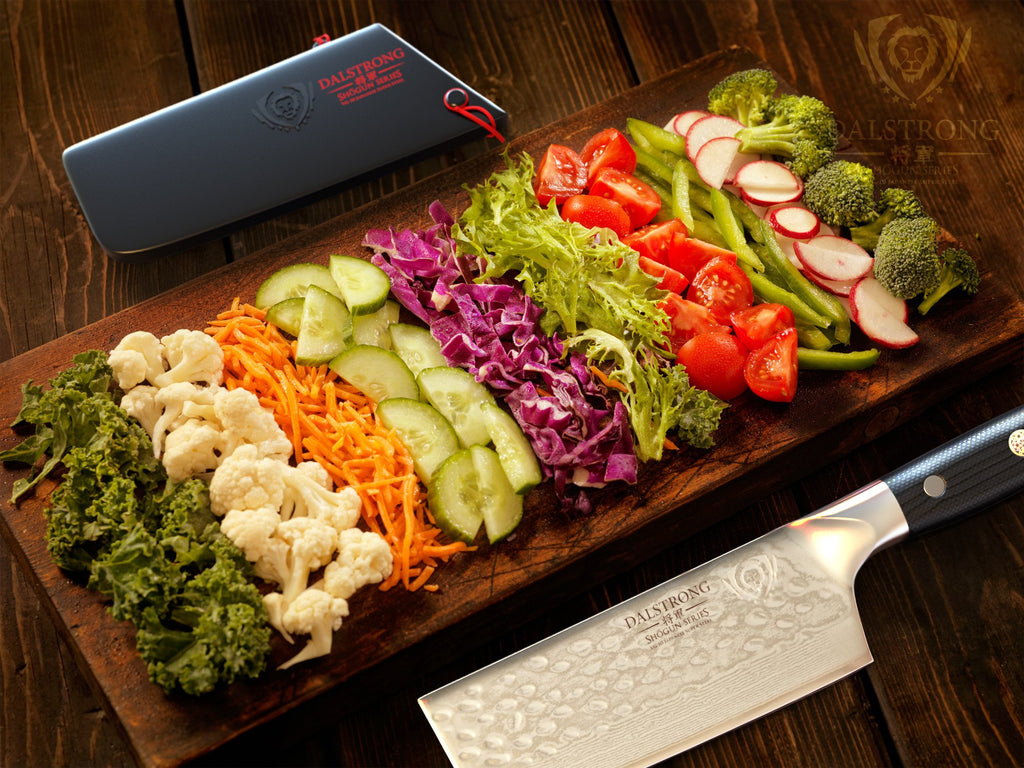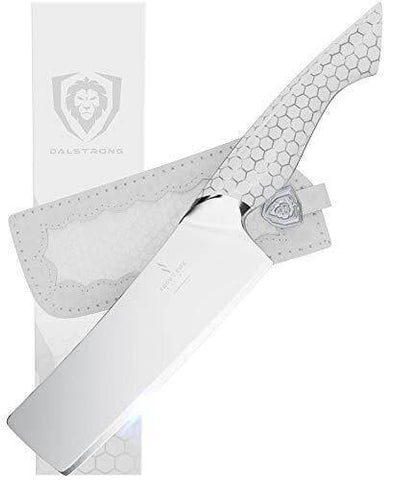6'' Nakiri Knife | Shogun Series | Dalstrong ©
What is a Nakiri Knife?
A nakiri knife is a Japanese style knife that is similar to a chef’s knife in that it is large and made for slicing and dicing whatever you throw its way. How a nakiri excels is in its rectangle blade with a flat edge.
A nakiri blade tends to look more like a Chinese cleaver, but is much lighter with a straight blade edge that enables precise cuts of all types of vegetables. You need a nakiri because of its thin blade and longer blade length and the fact that it’s the ideal vegetable knife to have.
6'' Nakiri Knife | Phantom Series | Dalstrong ©
Content Table
- What is a Nakiri Knife?
- How Do You Use a Nakiri Knife?
- What is the Difference Between a Nakiri and a Santoku?
- How to Shop for a Nakiri
- Top 7 Nakiri Knives
- Frequently Asked Questions
There’s an old phrase that goes something like, the more knives you have the easier your life is. Okay so it’s not an old phrase, it’s something I’ve just started saying religiously. But it’s true! There are so many different great knives that serve very specific functions in your kitchen. While you may not have heard of a nakiri knife until just now, trust me when I say you won’t know how you ever cooked without one.
We’ll give you the lowdown on what exactly a nakiri knife is, how to use it, how it differs from other Japanese knives, and give you a breakdown on what to look for when buying one, along with some of the top nakiris to keep your eye out for. Bottom line to remember: you want a nakiri in your life.
1. What Is A Nakiri Knife?
7'' Nakiri Knife | Omega Series | Dalstrong ©
A nakiri knife is a Japanese knife that is ideal for cutting up every type of veggie or mincing the smallest pieces of garlic. It is a unique kitchen knife because of its flat straight edge blade and its blade length which tends to be longer than many other prep knives.
Often compared to a cleaver, the nakiri is the perfect knife for creating clean cuts of root vegetables, hard to chop veggies, and even those delicate vegetables that sometimes squish under heavier, thicker blades.
Typically made from stainless steel, this Japanese knife has a straight edge perfect for chopping because it is so thin and light.
2. How Do You Use A Nakiri Knife?
7'' Nakiri Knife | Shadow Black Series | Dalstrong ©
The magic of cutting with the nakiri knife is that as long as you have a cutting board (preferably this magical cutting board that everyone needs in their kitchen) you’re pretty much ready to become a professional chef. All you need to know now is what kind of cut to make with a nakiri and then how to sharpen it.
To cut with a nakiri knife it’s all about the straight up and down chop. You can also slice forwards and backwards as long as your arm is still using that up and down motion. Unlike cutting with other knives, the Nakiri is a great knife made for precise cuts of vegetables so the up and down motion is everything you need and more.
The difference between most professional kitchens versus home kitchens is how well the pros take care of their tools. In terms of sharpening, the nakiri is no different than any of your other kitchen knives. We’ve got a stellar guide that will show you all the tips and knife sharpening tricks.
3. What Is The Difference Between A Nakiri And A Santoku?
7'' Nakiri Knife | Crusader Series | Dalstrong ©
While both knives are absolutely fantastic additions to your kitchen arsenal they do differ not only in blade shape, but in use. A nakiri knife has a rectangular blade and is mostly used for chopping vegetables whereas a santoku knife is more like an all purpose, traditionally shaped knife, used for a variety of kitchen cuts.
TLDR: Think of a santoku as a multipurpose chef’s knife and a nakiri as a vegetable knife.
A nakiri knife should also be used cutting with a straight up and down motion, but a santoku knife has a bit more play room in terms of the style of cutting. While the nakiri knife has a thin blade, a santoku knife tends to have a thicker blade.
4. How To Shop For A Nakiri
At this point I’m sure you’re convinced you need a nakiri in your life. And if you’re not then I would guess it’s because you’re not eating enough vegetables in your diet. Throw on your apron, start cooking more vegetables, then buy a nakiri to properly chop them.
Here’s what you should be looking for when you hit the shops in search of that perfect nakiri knife.
Weight
Something to keep in mind is that while nakiri knives are quite lightweight they may be a bit heavier than a santoku for example. A nakiri is always going to be a double-bevel knife, whereas a knife like the usuba is usually a single bevel blade. All this means that, yes, the nakiri will be a slightly heavier knife in your kitchen set. That said, we like a little extra heft when we have to slice through a huge, heavy watermelon.
Design
The best part about the nakiri design is that it was tailor made to cut vegetables. While most nakiri knives are designed similarly there are some subtle differences to keep your eye out for. For example, often the design will include a hollow edge that prevents vegetables from sticking to the knife.
There are other nakiris that use a granton edge, meaning there are divots on the side edges that reduce friction or drag when chopping. Some nakiris will have a hammered finish, others a normal straight edge. Whatever design you’re into just make sure it favors function over style.
Handle
For me a handle is a very important component to how comfortable I’ll be using the knife repeatedly. You want to keep an eye out for a handle that fits your hand nicely, is easy to clean, and most of all allows you to get a good pinch grip for when you’re chopping a large squash and things can get a little messy.
Steel Type
The best types of nakiris will be made from stainless steel. How much of that steel is low carbon stainless steel or high carbon steel will really depend on the knife. You’ll probably want something with higher carbon stainless steel as its edge retention is far superior to lower carbon knives, meaning you’ll have to sharpen it a whole lot less.
Price
This is always something you should consider when purchasing a knife. Typically a long lasting, Japanese steel knife will cost a pretty penny but the longevity of the knife makes up for the initial investment. Because it is such high carbon steel for the blade, consider spending anywhere from $100 to $200. If you can find a knife below $100 consider it a steal and buy two.
5. Top 7 Nakiri Knives To Buy
If you prepare vegetables of any kind in your kitchen I promise you a nakiri knife is everything you’ve ever needed and more. From its straight edge to its high scoring rockwell hardness scores this is the kind of knife that makes cooking easy. Here’s a short list of some of the absolute best nakiri knives on the market with a breakdown of their pros and cons.
1. Nakiri Knife 7” | Gladiator Series
This is the kind of vegetable knife that doesn’t make a fuss with its design but gets the job more than done. Tackle pineapples to eggplants to the tiniest baby tomatoes from your garden and watch as this high carbon steel blade slices and dices with ease.
Pros
- The perfect mix between a chef’s knife and a vegetable cleaver, this particular nakiri includes grooves on the edge that minimize stuck on food as you chop, chop, chop away.
- Its ambidextrous black G10 Garolite handle has been designed for utmost comfort and ability so that your hand won’t cramp as you create those precise cuts for that one recipe you’re conquering.
- With high carbon German ThyssenKrupp steel you can be sure that the blade won’t wear down as it maintains its ultra sharp edge.
Cons
- The average nakiri knife ranges between 5 to 7 inches in blade length. This nakiri is obviously on the longer end which you may or may not prefer. If you’re looking for a smaller option, consider a Santoku knife like this one.
- I love the classic look of this nakiri as it is sure to match most kitchen appliances and cutlery, but if you’re looking for a more modern design consider this nakiri.
- While the nakiri is the absolute perfect knife for chopping up your vegetables, if you want to slice proteins as well then you may consider investing in a chef knife instead.
2. Nakiri Knife 6” | Shogun Series X
I love most anything from the Shogun Series because of its sleek look and interesting detailed design. This damascus nakiri does not disappoint with its ruthless power and stunning elegance as it cuts through an entire vegetable feast.
Pros
- Made with ultra premium Japanese AUS-10V super steel this is the absolute pinnacle of high carbon stainless steel when it comes to knives. You just can’t beat it.
- The blade has been tapered to minimize surface resistance, plus its blade height allows for improved knuckle clearance, making your food transfer situation as easy as can be.
- It just looks good. With its hammered tsuchime finish you won’t get the same drag as other knives and the Tsunami Rose pattern on the blade gives it that added touch of charm.
Cons
- While I prefer a slightly smaller nakiri myself, this particular knife is an inch shorter than those 7” nakiris. If you’re looking for a longer blade consider the equally beautiful Omega Series nakiri.
- I’d argue that Japanese steel is priceless because of how long it lasts and how much sharpness its edges retain, but this nakiri is on the higher side of price points which may be something to consider.
- The style of this knife is all in the details. For those that prefer simple things, consider going with this classic look instead.
3. Nakiri Knife 7” | Shadow Black Series
Look like a warrior ready for battle with this aggressive all black nakiri. While its muscular design may not be for everyone, it is certainly a statement in the kitchen. The Shadow Black Series Nakiri radiates power and strength and has the scalpel-like edge to back it up.
Pros
- Its blade is made from one single piece of steel, meaning it is full tang, robust, and creates strong, precise cuts that make the up & down cutting motion of a nakiri effortless.
- Unlike a Wusthof classic style knife this nakiri knife has a bit more fun with its style. Its geometric all black design is bold and powerful, just like the knife itself.
- Of all the knives on this list, this handle may be the most comfortable. It tucks snugly into your palm and allows all different hand sizes the perfect fit as they slice and dice. Plus its slight texture aids with the no-slip as you chop.
Cons
- If you’re the kind of person who is looking for Japanese stainless steel only, then I’d consider checking out the Shogun Series knives.
- This bad boy is a 7” so if you’re in the market for a smaller blade length consider one of the 6” nakiri options, or the much, much smaller paring knife.
- The look of the Shadow Black Series knives, though bold and strong, is not for every cook nor for every kitchen. For a more traditional style, consider the Gladiator Series Nakiri.
4. Nakiri Knife 7” | Omega Series
It seems I have expensive taste because my two favorite knives on this list also happen to be the priciest. But this Omega Series 7” nakiri is absolutely stunning, shockingly sharp, and built to destroy those hard to cut vegetables for decades to come.
Pros
- The attention to detail on this knife is unparalleled. With its “LiquidMetal” pattern dispersed throughout the blade, and its sleek silver and black design you know you’ll look like a pro in the kitchen as you sling this knife around. Besides just flair, the design makes sure that food doesn’t stick to your knife as you chop.
- This particular blade has a more square tip but is still incredibly flat making those push cuts glide right through as if you were cutting air.
- Its edge retention rates at 63+ on the rockwell scale, and its sharpness comes in at 8-12°degree angle per side. In other words this knife will stay super sharp for a super long time.
Cons
- Much like the Shogun Series X nakiri, this price point is higher than other knives on this list. While price is something to consider, keep in mind you pay for premium steel and that steel tends to give back to you (in terms of delicious, easy meals) for years and years to come.
- Again, this is a 7” nakiri so if you’re in the market for a smaller size consider a 6.5” nakiri instead.
- For those of you that don’t love the cleaver-like look of nakiris, a santoku knife may be a better fit.
5. Vegetable Knife 6” | Phantom Series
This agile little vegetable knife is everything your kitchen has been craving. Its clean style, classic Japanese premium steel, and ergonomic handle gets the job done while making you look like an absolute pro.
Pros
- I can’t say enough about Japanese steel and how much I love it. This knife has six inches of precision forged Japanese AUS-8 steel at 58 HRC, so you know it’s good.
- There’s nothing pretentious about this blade. It isn’t trying to be fancy or unique. It’s not showy, it’s just ruthlessly sharp. It gets the job done.
- The rock hollow divots at the bottom of the blade are essential to a top of the line nakiri as it makes sure food doesn’t get stuck on the blade. It also makes the transfer from cutting board to saute pan as seamless as can be.
Cons
- The blade shape of this particular knife tends to be somewhat boxier than others on the list. If that’s not for you, take a look at the rest of the nakiri options.
- This knife has a traditional Japanese D-shaped black pakkawood handle that I absolutely love. But if you’re interested in a bit of a curvier handle, try the Gladiator Series Nakiri.
- The 6 inches here are perfect for me, but if you want a bit more blade you could consider an 8” chef knife.
6. Nakiri Knife 6.5” | Frost Fire Series
Coming in at the perfect in-between size, this 6.5” nakiri offers a little something different to those who like to play around with their kitchen style. Its precision-based sandblast finish means that food won’t stick and you’ll have a sleek frosted look to your knife for all to admire.
Pros
- This knife is incredibly sharp. Made with a 7-layer high-carbon and high-chromium steel its blade is razor sharp, and engineered to perfection.
- The look of this knife is absolutely unique, resembling a frost queen. Its white resin handle is enclosed in aluminum mesh and built to last.
- We can’t not talk about the size of this knife. It’s the perfect compromise between the 6” and 7” nakiri, offering a little bit more blade room, but not too much.
Cons
- I love having statement pieces in my wardrobe and in my kitchen but if you aren’t the type of person that likes to step outside of the box this won’t be the knife design for you.
- The handle is slender and made for a tension-free grip, but if you prefer a less curvy handle this nakiri may be a better fit for you.
- While not the highest price point on the scale this particular knife is slightly more expensive than other nakiri options.
7. Nakiri Knife 7” | Crusader Series
Last but certainly not least, this 7” nakiri knife is modern and exciting while still having all the elements we love about the classic nakiri style. Made from German steel it is high quality through and through.
Pros
- The unique seamless transition from blade to high-chromium stainless steel handle is really something to be admired. This knife is all steel all day and we are more than here for it.
- Speaking of steel, the German ThyssenKrupp x50crmov15 steel is absolutely fantastic and ensures a razor sharp edge that nails those precise cuts every single time.
- There is a groove along the knife blade that makes sure food doesn’t stick, but also provides an added lightness to the already lightweight nakiri style.
Cons
- This is a modern knife that has a style of its own. If you’re adventurous and futuristic go for the gold, but if you’re a more classic and reserved type you may not be as thrilled with the design as others.
- The minimalist handle, though made for maximum comfort and balance, is not entirely filled in which to me doesn’t sound quite as comfortable as many of the other handles on the list.
- Its shape looks very much like a traditional cleaver knife would. If you’re looking for that same shape but in a much smaller version than this 7” blade, consider this cleaver.
6. Frequently Asked Questions About Nakiri Knives
7'' Nakiri Knife | Gladiator Series | Dalstrong ©
What is a Nakiri knife used for?
Mainly cutting vegetables and creating delicious vegetarian creations. It’s perfect for those big fruits and vegetables and even those small shallots and garlic. That said, you could cut a variety of goods with it in a pinch.
Is a Nakiri knife worth it?
Absolutely. It makes such a great addition to your knife collection. If you cook a lot of vegetables (which let’s be real you should be!) I’d say it’s a necessary addition.
Is a Nakiri knife good for meat?
It is not the ideal knife for meat, no. That said, I’ve used it to slice a chicken or two in my day and it was absolutely fine. If you’re in the market for a more multi-use knife, I’d say go with a chef knife instead.
How do you chop with a Nakiri knife?
The nakiri chop is all about the up and down motion. It’s not a bread knife, nor a paring knife. It’s made for chopping veggies, people!
SHOP DALSTRONG NAKIRI KNIVES TODAY
Written by Monique NicholasBased in Vancouver, Monique enjoys jumping into bodies of water, sending postcards, and adding lemon to every single one of her dishes.































































